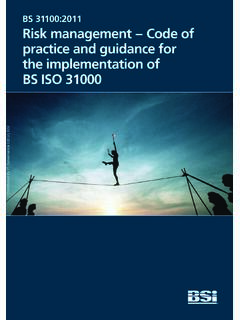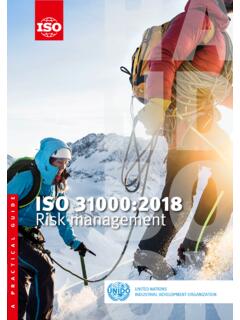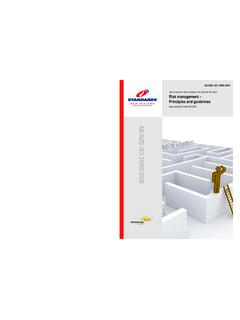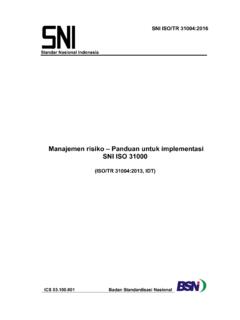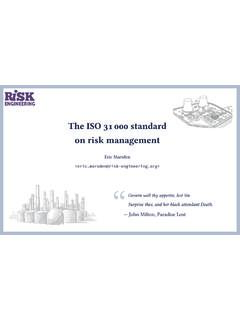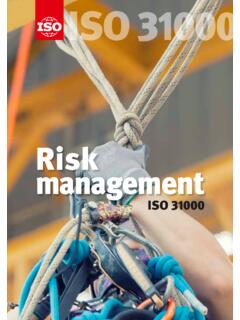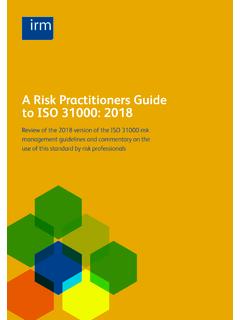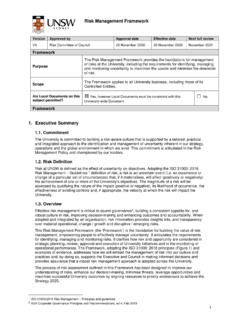Transcription of Risk Management Framework - DHS - Home
1 Risk Management Framework TTHHIISS PPAAGGEE IINNTTEENNTTIIOONNAALLLLYY LLEEFFTT BBLLAANNKK Foreword The South Australian Government Risk Management Policy Statement 2009 advocates that consistent and systematic application of risk Management is central to maximising community outcomes, deriving the benefit of opportunities, managing uncertainty and minimising the impact of adverse events. Consistent with this policy the Department for Communities and Social Inclusion (DCSI) is committed to protecting itself, employees and others from situations or events that would prevent it from achieving its strategic goals and objectives.
2 Risk Management is an integral part of good Management practice and the provision of safe workplace environments. A systematic approach to managing risks and opportunities is more effective and efficient than allowing informal, intuitive processes to operate. DCSI s adoption of a structured approach to risk Management : defines a process for systematically managing the risk of all functions and activities in the organisation; encourages a high standard of accountability at all levels of the organisation; supports effective corporate and clinical governance systems and reporting mechanisms; encourages a high standard of efficient and effective client focused care and service delivery by taking advantage of opportunities for improvement.
3 And allows the organisation to better meet its client and community demands. It is everyone s responsibility to be involved in the identification, evaluation and treatment of risks and opportunities that could impact or influence outcomes for the organisation. We trust this Framework is useful in assisting you to integrate risk Management into your role within the department. Andrew Thompson Executive Director Financial Services A5013136 Page 4 of 42 TABLE OF CONTENTS Foreword .. 3 1. Introduction .. 5 2. What is Risk Management ?
4 7 3. Risk Management principles .. 8 4. The Approach to Managing risks .. 10 5. The Risk Management Process .. 12 6. Roles and 16 7. Recording and Reporting Requirements .. 18 Appendices .. 21 Appendix 1 - SA Government Risk Management Policy 23 Appendix 2 DCSI Risk Management Policy .. 24 Appendix 3 - DCSI Risk Management Plan .. 27 Appendix 4 - Detailed Risk Management Process .. 28 Appendix 5 - Risk Categories and Potential Sources of Risk .. 36 Appendix 6 - DCSI Risk Assessment Matrix .. 37 Appendix 7 - DCSI Risk Escalation Flowchart.
5 39 Appendix 8 - DCSI Risk Management Glossary .. 40 Version December 2012 A5013136 Page 5 of 42 1. Introduction The purpose of this Framework is to; define risk Management ; outline the department s risk Management plan (Appendix 3); describe the approach to managing risks based on AS/NZS ISO 31000 :2009 principles ; outline guidance on the risk Management process with a detailed context (Appendix 4); outline roles and responsibilities for risk Management within the department; and explain the risk Management recording and reporting requirements within the department.
6 Risk Management is implemented in a manner consistent with three directive documents. They are: AS/NZS ISO 31000 :2009 Risk Management : principles and Guidelines The international risk Management standard states that the success of risk Management will depend on the effectiveness of the risk Management Framework providing the foundations and arrangements that will embed it throughout the organisation at all levels. The Framework ; assists in managing the risks effectively through the application of the risk Management process; ensures that the information about risks derived from the risk Management process is accurately reported; and that the information is used as a basis for decision making and accountability at all relevant organisational levels.
7 (AS/NZS ISO 31000 :2009) Available at (Use of this reference material is subjected to copyright laws DCSI can reproduce this document for internal use only) A5013136 Page 6 of 42 Government of South Australia Risk Management Policy Statement The Government of South Australia Risk Management Policy Statement 2009 states: the South Australian Government recognises that commitment to risk Management contributes to sound Management practice and increasing community confidence in government performance Further, the Risk Management Policy Statement indicates that the Chief Executive of the Department for Communities and Social Inclusion (DCSI) is accountable to the relevant ministers for the development and implementation of a risk Management Framework specific to the departments business and organisational needs.
8 The key principle which underpins this statement is that risk Management contributes to the creation of sustainable value . (The Policy Statement is contained in Appendix 1) DCSI Risk Management Policy The DCSI Risk Management Policy confirms the department s commitment to identify, assess and manage risks which may prevent the achievement of strategic goals and objectives. Risk Management is regarded as an integral part of good Management practice and the provision of safe workplace environments. The policy directs that the department will integrate risk Management into its culture, decision-making processes, programs, practices, business planning and performance reporting activities and will establish a safe working environment for its staff.
9 The DCSI Risk Management Policy is applicable to the whole of organisation as per organisational structure below: (The policy is contained in Appendix 2) Chief Executive Policy & Community Development Financial Services Disability & Domiciliary Care Services Youth Justice, Community Engagement & Organisational Support Disability SA Multicultural SA State Recovery Human Resources Office for Women Housing SA risk Management contributes to the creation of sustainable value A5013136 Page 7 of 42 2. What is Risk Management ? Risk Management is about managing threats and opportunities.
10 AS/NZS ISO 31000 :2009 describes risk as the effect of uncertainty on objectives When Management of risks or opportunities is effective, it often remains unnoticed. When it fails, the consequences for clients and staff may be significant and politically high profile. Having good risk Management practice ensures that the department can undertake activities with the knowledge that measures are in place to maximise the benefits and minimise the negative effect of uncertainties on organisational objectives. The risk Management process is a systematic application of Management policies, procedures and practices to the activities of communicating and consulting, establishing the context, identifying, analysing, evaluating, treating, monitoring and reviewing risk.


